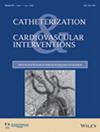Outcomes among patients with non-ST-elevation myocardial infarction on chronic anticoagulation: Insights from the National Inpatient Sample
Abstract
Background
Chronic systemic anticoagulation use is prevalent for various thromboembolic conditions. Anticoagulation (usually through heparin products) is also recommended for the initial management of non-ST-elevation myocardial infarction (NSTEMI).
Aims
To evaluate the in-hospital outcomes of patients with NSTEMI who have been on chronic anticoagulation.
Methods
Using the National Inpatient Sample (NIS) years 2016–2020, NSTEMI patients and patients with chronic anticoagulation were identified using the appropriate International Classification of Diseases, 10th version (ICD-10) appropriate codes. The primary outcome was all-cause in-hospital mortality while the secondary outcomes included major bleeding, ischemic cerebrovascular accident (CVA), early percutaneous coronary intervention (PCI) (i.e., within 24 h of admission), coronary artery bypass graft (CABG) during hospitalization, length of stay (LOS), and total charges. Multivariate logistic or linear regression analyses were performed after adjusting for patient-level and hospital-level factors.
Results
Among 2,251,914 adult patients with NSTEMI, 190,540 (8.5%) were on chronic anticoagulation. Chronic anticoagulation use was associated with a lower incidence of in-hospital mortality (adjusted odds ratio [aOR]: 0.69, 95% confidence interval [CI]: 0.65−0.73, p < 0.001). There was no significant difference in major bleeding (aOR: 0.95, 95% CI: 0.88−1.0, p = 0.15) or ischemic CVA (aOR: 0.23, 95% CI: 0.03−1.69, p = 0.15). Chronic anticoagulation use was associated with a lower incidence of early PCI (aOR: 0.78, 95% CI: 0.76−0.80, p < 0.001) and CABG (aOR: 0.43, 95% CI: 0.41−0.45, p < 0.001). Chronic anticoagulation was also associated with decreased LOS and total charges (adjusted mean difference [aMD]: −0.8 days, 95% CI: −0.86 to −0.75, p < 0.001) and (aMD: $−19,340, 95% CI: −20,692 to −17,988, p < 0.001).
Conclusions
Among patients admitted with NSTEMI, chronic anticoagulation use was associated with lower in-hospital mortality, LOS, and total charges, with no difference in the incidence of major bleeding.

 求助内容:
求助内容: 应助结果提醒方式:
应助结果提醒方式:


